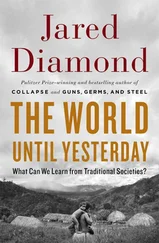Jared Diamond - Guns, Germs & Steel
Здесь есть возможность читать онлайн «Jared Diamond - Guns, Germs & Steel» весь текст электронной книги совершенно бесплатно (целиком полную версию без сокращений). В некоторых случаях можно слушать аудио, скачать через торрент в формате fb2 и присутствует краткое содержание. Жанр: 105. Описание произведения, (предисловие) а так же отзывы посетителей доступны на портале библиотеки ЛибКат.
- Название:Guns, Germs & Steel
- Автор:
- Жанр:
- Год:неизвестен
- ISBN:нет данных
- Рейтинг книги:5 / 5. Голосов: 1
-
Избранное:Добавить в избранное
- Отзывы:
-
Ваша оценка:
- 100
- 1
- 2
- 3
- 4
- 5
Guns, Germs & Steel: краткое содержание, описание и аннотация
Предлагаем к чтению аннотацию, описание, краткое содержание или предисловие (зависит от того, что написал сам автор книги «Guns, Germs & Steel»). Если вы не нашли необходимую информацию о книге — напишите в комментариях, мы постараемся отыскать её.
Guns, Germs & Steel — читать онлайн бесплатно полную книгу (весь текст) целиком
Ниже представлен текст книги, разбитый по страницам. Система сохранения места последней прочитанной страницы, позволяет с удобством читать онлайн бесплатно книгу «Guns, Germs & Steel», без необходимости каждый раз заново искать на чём Вы остановились. Поставьте закладку, и сможете в любой момент перейти на страницу, на которой закончили чтение.
Интервал:
Закладка:
44o ' FURTHER READINGS
and Peoples (Garden City, N.Y.: Doubleday, 1976). The last book, written by a distinguished historian rather than by a physician, has been especially influential in bringing historians to recognize the impacts of disease, as have been the two books by Alfred Crosby listed under the further readings for the Prologue.
Friedrich Vogel and Arno Motulsky, Human Genetics, 2nd ed. (Berlin: Springer, 1986), the standard textbook on human genetics, is a convenient reference for natural selection of human populations by disease, and for the development of genetic resistance against specific diseases. Roy Ander-son and Robert May, Infectious Diseases of Humans (Oxford: Oxford University Press, 1992), is a clear mathematical treatment of disease dynamics, transmission, and epidemiology. MacFarlane Burnet, Natural History of Infectious Disease (Cambridge: Cambridge University Press, 1953), is a classic by a distinguished medical researcher, while Arno Kar-len, Man and Microbes (New York: Putnam, 1995), is a recent popular account.
Books and articles specifically concerned with the evolution of human infectious diseases include Aidan Cockburn, Infectious Diseases: Their Evolution and Eradication (Springfield, 111.: Thomas, 1967); the same author's "Where did our infectious diseases come from?" pp. 103-13 in Health and Disease in Tribal Societies, CIBA Foundation Symposium, no. 49 (Amsterdam: Elsevier, 1977); George Williams and Randolph Nesse, "The dawn of Darwinian medicine," Quarterly Reviews of Biology 66:1-62 (1991); and Paul Ewald, Evolution of Infectious Disease (New York: Oxford University Press, 1994).
Francis Black, "Infectious diseases in primitive societies," Science 187:515-18 (1975), discusses the differences between endemic and acute diseases in their impact on, and maintenance in, small isolated societies. Frank Fenner, "Myxoma virus and Oryctolagus cuniculus: Two colonizing species," pp. 485-501 in H. G. Baker and G. L. Stebbins, eds., Genetics of Colonizing Species (New York: Academic Press, 1965), describes the spread and evolution of Myxoma virus among Australian rabbits. Peter Panum, Observations Made during the Epidemic of Measles on the Faroe Islands in the Year 1846 (New York: American Public Health Association, 1940), illustrates how the arrival of an acute epidemic disease in an isolated nonresistant population quickly kills or immunizes the whole population. Francis Black, "Measles endemicity in insular populations: Critical community size and its evolutionary implication," Journal of Theoretical
FURTHER READINGS – 441
Biology 11:207-11 (1966), uses such measles epidemics to calculate the minimum size of population required to maintain measles. Andrew Dob-son, "The population biology of parasite-induced changes in host behavior," Quarterly Reviews of Biology 63:139-65 (1988), discusses how parasites enhance their own transmission by changing the behavior of their host. Aidan Cockburn and Eve Cockburn, eds., Mummies, Diseases, and Ancient Cultures (Cambridge: Cambridge University Press, 1983), illustrates what can be learned from mummies about past impacts of diseases.
As for accounts of disease impacts on previously unexposed populations, Henry Dobyns, Their Number Became Thinned (Knoxville: University of Tennessee Press, 1983), marshals evidence for the view that European-introduced diseases killed up to 95 percent of all Native Americans. Subsequent books or articles arguing that controversial thesis include John Verano and Douglas Ubelaker, eds., Disease and Demography in the Americas (Washington, D.C.: Smithsonian Institution Press, 1992); Ann Ramenofsky, Vectors of Death (Albuquerque: University of New Mexico Press, 1987); Russell Thornton, American Indian Holocaust and Survival (Norman: University of Oklahoma Press, 1987); and Dean Snow, "Microchronology and demographic evidence relating to the size of the pre-Columbian North American Indian population," Science 268:1601-4 (1995). Two accounts of depopulation caused by European-introduced diseases among Hawaii's Polynesian population are David Stannard, Before the Horror: The Population of Hawaii on the Eve of Western Contact (Honolulu: University of Hawaii Press, 1989), and O. A. Bushnell, The Gifts of Civilization: Germs and Genocide in Hawaii (Honolulu: University of Hawaii Press, 1993). The near-extermination of the Sadlermiut Eskimos by a dysentery epidemic in the winter of 1902-3 is described by Susan Rowley, "The Sadlermiut: Mysterious or misunderstood?" pp. 361-84 in David Morrison and Jean-Luc Pilon, eds., Threads of Arctic Prehis tory (Hull: Canadian Museum of Civilization, 1994). The reverse phenomenon, of European deaths due to diseases encountered overseas, is discussed by Philip Curtin, Death by Migration: Europe's Encounter with the Tropical World in the 19th Century (Cambridge: Cambridge University Press, 1989).
Among accounts of specific diseases, Stephen Morse, ed., Emerging Viruses (New York: Oxford University Press, 1993), contains many valuable chapters on "new" viral diseases of humans; so does Mary Wilson et al., eds., Disease in Evolution, Annals of the New York Academy of Sci-
4 4 2, • FURTHER readings
ences, vol. 740 (New York, 1995). References for other diseases include the following. For bubonic plague: Colin McEvedy, "Bubonic plague," Sci entific American 258(2):118-23 (1988). For cholera: Norman Longmate King Cholera (London: Hamish Hamilton, 1966). For influenza: Edwin Kilbourne, Influenza (New York: Plenum, 1987), and Robert Webster et al., "Evolution and ecology of influenza A viruses," Microbiological Reviews 56:152-79 (1992). For Lyme disease: Alan Barbour and Durland Fish, "The biological and social phenomenon of Lyme disease," Science 260:1610-16 (1993), and Allan Steere, "Lyme disease: A growing threat to urban populations," Proceedings of the National Academy of Sciences 91:2378-83(1994).
For the evolutionary relationships of human malarial parasites: Thomas McCutchan et al., "Evolutionary relatedness of Plasmodium species as 3 determined by the structure of DNA," Science 225:808-11 (1984), and A. P. Waters et al., "'Plasmodium falciparum appears to have arisen as a result of lateral transfer between avian and human hosts," Proceedings of the National Academy of Sciences 88:3140-44 (1991). For the evolutionary relationships of measles virus: E. Norrby et al., "Is rinderpest virus the archevirus of the Morbillivirus genus?" Intervirology 23:228-32 (1985), and Keith Murray et al., "A morbillivirus that caused fatal disease in horses and humans," Science 268:94-97 (1995). For pertussis, also known as whooping cough: R. Gross et al., "Genetics of pertussis toxin," Molecu lar Microbiology 3:119-24 (1989). For smallpox: Donald Hopkins, Princes and Peasants: Smallpox in History (Chicago: University of Chicago Press, 1983); F. Vogel and M. R. Chakravartti, "ABO blood groups and smallpox in a rural population of West Bengal and Bihar (India)," Human Genetics 3:166-80 (1966); and my article "A pox upon our genes," Natural History 99(2):26-30 (1990). For monkeypox, a disease related to smallpox: Zdenek Jezek and Frank Fenner, Human Monkeypox (Basel: Karger, 1988). For syphilis: Claude Quetel, History of Syphilis (Baltimore: Johns Hopkins University Press, 1990). For tuberculosis: Guy Youmans, Tuberculosis (Philadelphia: Saunders, 1979). For the claim that human tuberculosis was present in Native Americans before Columbus's arrival: in favor, Wilmar Salo et al., "Identification of Mycobacteriutn tuberculosis DNA in a pre-Columbian Peruvian mummy," Proceedings of the National Academy of Sciences 91:2091-94 (1994); opposed, William Stead et al., "When did Mycobacterium tuberculosis infection first occur 10
Интервал:
Закладка:
Похожие книги на «Guns, Germs & Steel»
Представляем Вашему вниманию похожие книги на «Guns, Germs & Steel» списком для выбора. Мы отобрали схожую по названию и смыслу литературу в надежде предоставить читателям больше вариантов отыскать новые, интересные, ещё непрочитанные произведения.
Обсуждение, отзывы о книге «Guns, Germs & Steel» и просто собственные мнения читателей. Оставьте ваши комментарии, напишите, что Вы думаете о произведении, его смысле или главных героях. Укажите что конкретно понравилось, а что нет, и почему Вы так считаете.










